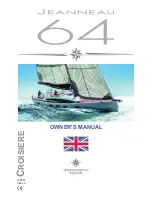
W
I N T E R I Z A T I O N A N D
S
T O R A G E
7–2
For outdoor storage, a canvas cover should be used to prevent “sweating”. One method is to
build a frame over the boat to support the canvas. It should be a few inches wider than the boat so
the canvas will clear the rails and allow passage of air. The cover should be fastened securely so
that winds cannot remove it or cause it to chafe the boat. A poor covering job will eventually cost
more than the price of a well-made cover.
C
LEANING
A
ND
L
UBRICATING
T
HE
B
OAT
Clean and wax the boat before storage. If your boat stays in the water, there may be a layer of
growth on the bottom. This debris will harden as it dries. Clean, scrub, and scrape the bottom
promptly when the boat is removed from the water. Thoroughly remove all marine growth and
other foreign matter from the hull. Clean the inside of hull openings, thru hull fittings, and
scupper drains. Inspect the hull bottom for damage.
Check cleats and rails for corrosion and tightness. Clean all stainless steel as directed under
“Cleaning” on page 6–1
. Use a good quality metal preservative like T-9® on all metal surfaces to
prevent salt water damage. Check all hinges for corrosion — lubricate hinges as necessary. Check
for loose silicone, hinges, and unseated gaskets; replace or tighten where necessary. Heavy seas
pounding and twisting the hull can cause leaks in your windows, doors, and hatches.
D
RAINING
A
ND
W
ATER
S
YSTEMS
If the boat is stored out of water, remove the garboard drain plug to keep the bilge dry. Store
your boat with the bow elevated for drainage.
Drain all water tanks, lines, and pumps to prevent freeze damage. The fresh water system may
be drained by running any faucet until the tank is empty. When the tank is empty, turn the water
pump off to prevent damage — residual water will not damage the tank. The water heater must be
drained individually after emptying the water tank. Drain the water heater by opening the drain
faucet on the water heater. If desired, the fresh water system may have a non-toxic antifreeze for
potable water systems added.
To drain other lines, close seacocks and run the pumps until the lines are dry. Open the
seacocks after lines are dry. Draining will help prevent water stagnation in warmer climates.
H
EAD
S
YSTEM
Empty toilet and holding tank making sure all water is cleared. Reference Owner’s Packet for
manufacturer’s information on winterization. Water should be removed from deck pump-out
lines.
W A R N I N G
If the boat is shrink wrapped with plastic during storage, the fuel fill and vent fitting must be
outside of the enclosure to prevent the trapping of dangerous fumes or spillage from thermal
expansion.
!
















































